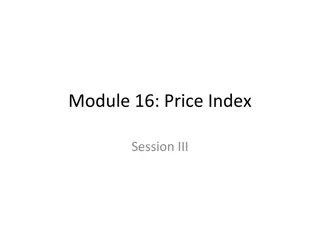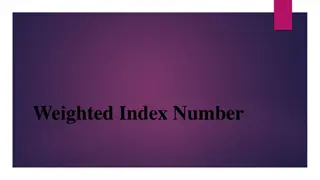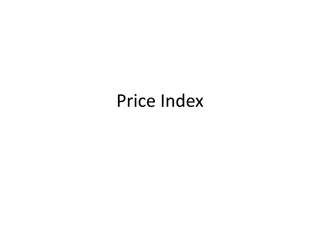Constructing Price Index: General Procedure and Aggregation
The process of constructing a price index involves various steps such as computation of price relatives, aggregation at different levels, selection of base period, and designing data collection methods. Weighted arithmetic mean and simple ratio calculations are used in aggregating price indices. A three-step compilation procedure is typically followed, culminating in the overall price index. Specific details and practices are outlined for each step involved in the construction of price indices.
Download Presentation

Please find below an Image/Link to download the presentation.
The content on the website is provided AS IS for your information and personal use only. It may not be sold, licensed, or shared on other websites without obtaining consent from the author.If you encounter any issues during the download, it is possible that the publisher has removed the file from their server.
You are allowed to download the files provided on this website for personal or commercial use, subject to the condition that they are used lawfully. All files are the property of their respective owners.
The content on the website is provided AS IS for your information and personal use only. It may not be sold, licensed, or shared on other websites without obtaining consent from the author.
E N D
Presentation Transcript
Module 16: Price Index Session V
Contents Session V Construction of Price Index Part II General Procedure of Index Aggregation Choice of base period 2
General Procedure of Index Aggregation Computation of price relatives Computation of elementary price index elementary aggregation Computation of higher level price index aggregating elementary price indices
General Procedure of Index Aggregation Constructing Price Index Steps involved, in practice Specifying geographical and population coverage. Identifying the products to be included in the basket and grouping them for elementary levels of aggregation [discussed in some more detail in Session VI] Selecting a compilation method and base period. Deriving weighting structure Designing price data collection frequency, outlets, product specification and quotations [discussed in some more detail in the following sessions] Index calculation in practice [discussed in some more detail in the following sessions]
General Procedure of Index Aggregation Construction of Price Index Numbers Price indices are compiled step-by-step. At every step the lower-level indices are aggregated to obtain the higher levels ones, up to the overall index. Normally, a three-step procedure is followed. A general procedure of constructing price index is indicated in the next slide. 5
General Procedure of Index Aggregation Aggregation Structure A General Procedure of constructing price index Upper aggregated price index Weighted arithmetic mean of price relatives by using fixed weight (Laspeyres / Lowe method) Price index for elementary aggregates Simple arithmetic / geometric mean of price relatives or ratio of average prices Price relatives for each item Simple ratio of prices in current and base periods Prices for each item in current and base period 6
General Procedure of Index Aggregation Three-Step Compilation First step: Calculation of price relatives. Price relative is calculated for each quotation as the ratio between the quoted current-period price (numerator) and the base- period price (denominator). Second step: Price relatives are aggregated to obtain the elementary price index (or elementary product index in the PPI context). Third step: The elementary price indices are aggregated as weighted averages (typically as a Laspeyres-type index) to provide a set of synthetic indices up to the overall index. 7
General Procedure of Index Aggregation First Step computation of price relatives Price quotations are first converted to ratios or price relatives, by dividing each current price by index-base price. For each period a fixed number of price quotations for a group of specified products (according to product specification) constituting an elementary aggregate are collected. The price relatives are calculated for each specified product as the ratio between the current period s price and the base- period price. 8
General Procedure of Index Aggregation First Step An example In compilation of a CPI, Elementary aggregate: rice . Number of varieties (say course , medium and fine ): 3 HES data provides weights for rice but not for its varieties. Number of outlets selected for price collection: Number of quotations collected from 10 outlets: 10 for coarse rice 6 for medium rice 4 for fine rice . Number of price relatives required to be calculated: 20 (for each quotation) 10 20 9
General Procedure of Index Aggregation Second Step computation of elementary index (1) The price relatives for each specified group of products elementary aggregate (for CPI) and product index (for PPI) are then aggregated to obtain the elementary price index. The price index for an elementary aggregate is called an elementary price index. Recall that an elementary aggregate is the lowest level of aggregation for which value data are available. In our example of rice in CPI compilation, all the price relatives for quotations collected for rice are combined, or aggregated, to obtain the elementary price index for rice . 10
General Procedure of Index Aggregation Second Step computation of elementary index (2) Likewise, for PPI, prices for different types of transactions for a product are collected from an establishment. The derived price relatives are combined to produce the product index for the establishment. Again, weights for individual transactions are usually not available. Thus, the establishment s product index is computed as an unweighted average of the price relatives for different transactions. 11
General Procedure of Index Aggregation Second Step computation of elementary index (3) The elementary price index or an establishment s product index are compiled in several ways. Mainly, two methods can be distinguished: the weighted mean of price relatives. the unweighted mean of price relatives. We will discuss only the applications of formulas that do not use explicit weights, i.e. Dutot s, Carli s and Jevon s. 12
General Procedure of Index Aggregation Second Step Dutot s for elementary index Note that, Dutot s index can be also be expressed as weighted averages of price relatives. Since, ???? ???0= ? ??? ??0 ??0 ???0 . ??0 ???0 (= 1) is the weight for ith quotation. Thus, the Dutot s index gives each price relative the weight equal to the share of its price in the sum of the prices in the base period. It is not suitable if the spread of prices being aggregated is too large, i.e. the prices are heterogeneous. where 13
General Procedure of Index Aggregation Second Step Carli s for elementary index Recall the formula for the Carli s index: 1 ? ? ??? ??0 Carli s index gives equal weights to all the quotations and thus to all the varieties. For CPI compilation, it is subjected to upward bias under rising-price situation, as the consumers are likely to shift to varieties with low relative prices. The equal weights of 1/n assigned to all the varieties will no longer be valid. 14
General Procedure of Index Aggregation Second Step Jevon s for elementary index Jevon s index is the geometric average of the price relatives both calculations will yield the same results. It is being introduced by more and more countries for calculation of elementary index. The Jevon s index gives each price relative the same (multiplicative) weights. 15
General Procedure of Index Aggregation Third Step computation of higher-level index (1) The elementary aggregates are combined to produce the sub-group and group indices, and eventually the overall index. For this, some kind of index number formula and weights are used. expenditure or population (for CPI) value of production (for PPI). Generally, the Laspeyres type index is used by statistical offices for higher-level indices. 16
General Procedure of Index Aggregation Third Step computation of higher-level index (2) Weighted arithmetic mean of elementary price indices is used for higher-level indices. Each of elementary aggregates (product or product group) is given a weight , based on consumption expenditure or output or sales during the reference (base) period for the weights. The elementary price indices are multiplied by their respective weights to obtain higher-level aggregate price index. 17
General Procedure of Index Aggregation Example 17: Process of Aggregation (1) Consider a hypothetical situation where the overall price index is compiled from just three broad groups of products cereals, other food and non- food with weights 20%, 45% and 35% respectively. The broad group cereal consists of only products (elementary aggregates) rice and flour. For rice, 8 quotations are collected every month and for flour 6 quotations. The table on the next slide shows the price quotations for rice and flour.
General Procedure of Index Aggregation Example 17: Process of Aggregation (1) Elementary aggregate - Cereals Rice elementary price index (Jevon's) Quotation no. Period / price relative 1 2 3 4 5 6 7 8 base year 25 27 25 26 22 23 25 24 current month 33 32 36 34 30 31 35 32 price relative 1.3 1.2 1.4 Calculate these values in your workbook 1.3 1.4 1.3 1.4 1.3 133.5 Flour base year 42 40 43 39 37 44 x x current month 51 55 58 49 53 50 x x Calculate these values in your workbook price relative 1.2 1.4 1.3 1.3 1.4 1.1 x x 129.0 First, the price relatives for each of the quotations are obtained as the ratio of current-period price to that of the base period. This is the first step. Next the second step the elementary price indices for rice and flour are calculated as unweighted geometric mean of the price relatives.
General Procedure of Index Aggregation Example 17: Process of Aggregation (2) The third step usually consists of different stages of aggregation to obtain higher level price indices. Once the elementary price index for rice and flour are obtained, we can calculate the price index for the Cereals broad group as follows (with the given weights of 60% and 40% for rice and flour respectively): Elementary aggregate in Cereals broad group weights(%) within Cereals group elementary index 60 133.5 Rice 40 129.0 Flour 131.7 Price index of cereals: Calculate these values in your workbook
General Procedure of Index Aggregation Example 17: Process of Aggregation (3) The value of index 131.7 is obtained as weighted arithmetic average of elementary price indices of rice and flour. Now, let s assume the price index for the broad groups otherfood and non-food are similarly obtained as 135.3 and 145.2. Finally, all the group price indices are combined, using the assigned weights of 20%, 45% and 35% respectively for cereals , otherfood and non-food , to obtain the overall price index as follows: Weights Broad group broad group (%) index Calculate the value in your workbook Cereals 20 131.7 Other food 45 135.3 Non-food 35 145.2 Overall price index: 138.0
Choice of Base Period Desirable properties of all the reference periods Rebasing how frequently?
Constructing Price Index Base Period Choice of Base or Reference period A base period is a conventional time interval such as a year, a month, etc. The following consideration are kept in mind while selecting a base period. (i) Base period should be a period of normal and stable economic conditions. But a period which is normal in one respect may be abnormal in some other respects. Thus, sometimes an average of two or more years is taken as the base period. (ii) The base period should not be too distant from the given period. (iii) ) Sometimes a year of some economic importance for the country is also taken as base. 23
Constructing Price Index Base Period Desirable properties of reference periods All the reference periods Index reference period, Weight reference period and Price reference period should desirably be long enough to cover a seasonal cycle, which is normally a year have economic conditions that can be considered to be reasonably normal or stable not be too distant from each other. An index series may also be re-referenced to another period by simply dividing the series by the value of the index in that period, without changing the rate of change of the index. 24
Constructing Price Index Base Period Example 18: Re-referencing a Price Index Consider the following price index series with index reference period as the year 2005. To obtain the series with base year re-referenced to 2010, we have to divide the values of price index with base year 2005 by the value of price index of 2010 (125.0) and multiply by 100. (Re-referenced) Price index 2008 2005 2006 2007 2009 2010 2011 2012 base year 2005 100.0 102.4 108.3 115.0 119.7 125.0 130.2 138.5 2010 80.0 81.9 Calculate these values in your workbook 86.6 92.0 95.8 100.0 104.2 110.8 Calculate the series with base year re-referenced to 2010. One has to divide the values of price index with base year 2005 by the value of price index of 2010 (125.0) and multiply by 100.
Rebasing Why Rebasing? In a changing world, it does not take very long before an index becomes out-of-date, for two main reasons: the weights no longer reflect the patterns of expenditure, output or trade new products come on to the market that did not exist before. The index ceases to represent the present-day price change.
Rebasing Updating Product Coverage For an elementary aggregate, prices of only a set of selected specific products is assumed to capture the price movement of the entire elementary aggregate. But, products become obsolete and new products come to the market. This introduces bias in the elementary indices, particularly when the price movement of the new products is very different from the ones already in the basket of goods or services of the elementary aggregate in question.
Rebasing Example 19: Bias in elementary index due to new product coming to the market Introduction of Product C, after the 2008 (base period), but the price index do not reflect the effect of price change of product C. Products Elementary index (Jevon s) Price A B C 08) 13 4 -- In 2008 (?? 18) 15 5 10 In 2018 (?? Price relatives 2008 2018 1.15 1.25 -- 1.20
Rebasing Rebasing weights Usually, while rebasing a price index series, an entirely new set of units or outlets are selected for price collection. Most countries use a fixed-weight index and do not change the selected set of outlets or units till the next rebasing is done. This leads to progressively increasing biases in the index numbers, with the actual consumption pattern shifts away from base year weighting structure.
Rebasing Example 20: Changes in group index with changes in weighting structure The weights in the base period and the current period are very different. The price index with 2008 weights is very different from the one with current weights. products weight / cost total A B C Weight (wi08) in 2008 Prices (pi08) in 2008 Weight (wi18) in 2018 Prices (pi18) in 2018 1.0 0.5 0.4 0.1 13 4 5 0.3 0.3 0.4 15 5 10 Price relatives 2008 2018 (pr) 1.15 1.25 2.00 pr * wi08 pr * wi18 0.58 Calculate these values in your workbook 0.50 0.20 1.28 0.35 0.38 0.80 1.52























